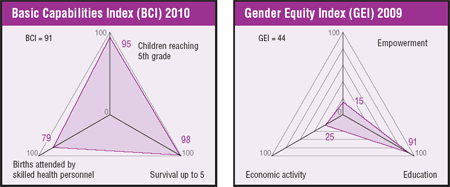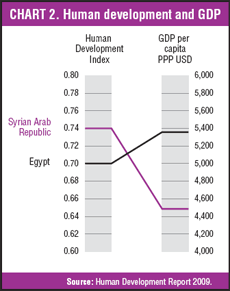The rough road to the Millennium Development Goals
The Egyptian Association for Community Participation Enhancement (EACPE)
Nawara Magdy Belal
Yasmine Sherif Ismail
Although official reports continue to emphasize that Egypt is on track to achieve the Millennium Development Goals (MDGs), the country has shown only limited progress on some of these. In the midst of the worst global economic crisis since the Great Depression of the 1930s, Egypt should embark on some profound changes and adopt radical development strategies to move towards fulfilling the internationally agreed goals. This requires development assistance to be more efficiently managed, while employment targeted projects should be increasingly negotiated and encouraged, along with more partnership with private sector and civil society.
 |
According to the Kuwaiti financial investment firm Global Investment House, the impact of the global economic crisis is now being felt in Egypt, although "Egypt’s healthy economic growth, along with the implemented reform is believed to protect the country’s economic performance throughout the concurrent global crisis.” True, the Egyptian economy has preserved its real GDP growth, which stood at 5.8% during the first quarter of fiscal year 2008-09 (July-September 2008), compared to the 6.5% achieved in the first quarter of fiscal year 2007-08. However it must be noted that the Government set a lower GDP growth target of 5.5% for fiscal year 2008-09, after realizing growth of 7.2% in fiscal year 2007-08. For fiscal years 2008-09 and 2009-10, respectively, the World Bank has forecast GDP growth rates of 4.5% and 6.0%.[1]
But is the crisis affecting the country’s progress in achieving the MDGs? According to an MDG midpoint assessment report, issued by the Ministry of Economic Development, the country is “on the right track to realizing most of the Millennium Development Goals by the set date of 2015.”[2] According to Egypt's Minister of Economic Development, Othman Mohamed Othman, “geographic targeting and other integrated social policies promise to reduce regional lags and gaps…and to also ensure the full realization of national MDG goals in all of Egypt.”[3] Regarding poverty reduction, the Minister announced that "the poverty rate has fallen from 31% to 26% in rural areas and from 13% to 8.6% in urban areas."[4] These figures however were denied by Gawdat el-Malt, president of the Egyptian Central Audit Agency, who reported that "poverty is estimated at 40% in rural areas and 18% in urban areas."[5]
Poverty is not only about income
These contradictory measurements are both based on income levels. However, poverty is not just about income and there are other major aspects to be considered, such as health, hygiene and social exclusion. Thus, composite measures, such as the Human Development Index (HDI) and the Human Poverty Index (HPI), which focus on the proportion of people living below certain thresholds in each of the dimensions of the HDI, should be taken into account.
In its Egypt National Report 2008, the UNDP highlighted seven guidelines that the Egyptian Government should take into account in order to achieve pro-poor economic growth:[6]
- The vulnerability of the poor to risk and the lack of social protection reduce the pace of growth.
- Inequality of assets and opportunity hinders the ability of poor people to participate in and contribute to growth. Gender is a particularly important dimension of inequality.
- Policies need to tackle the causes of market failure and improve market access. Market failure hurts the poor disproportionately. Programs are needed to ensure that markets that matter for their livelihoods work better for the poor.
- Both the pace and pattern of growth are critical for long-term and sustainable poverty reduction.
- Pro-poor growth requires the participation of the poor in the growth process.
- Policies to tackle the multiple dimensions of poverty should go hand-in-hand; perceptions of dichotomies (e.g., economic versus social policies) can be misplaced.
- The poor need to participate in and influence the policy reform process that goes with poverty reduction strategies.
The 2009 Human Development Report ranks Egypt 82nd among 135 countries for which the index has been calculated. The poverty index measures severe health deprivation by the proportion of people who are not expected to survive to age 40. Education is measured by the adult illiteracy rate. And a decent standard of living is measured by the un-weighted average of people not using an improved water source and the proportion of children under age five who are underweight for their age. Chart 1 shows the values for these variables for Egypt and compares them to other countries".
|
Selected indicators of human poverty |
||||
|
Human Poverty Index |
Probability of not surviving to age 40 |
Adult illiteracy rate |
People not using an improved water source |
Children underweight for age |
|
1. Czech Republic (1.5) |
1. Hong Kong, China (SAR) (1.4) |
1. Georgia (0.0) |
1. Barbados (0) |
1. Croatia (1) |
|
80. Solomon Islands (21.8) |
68. Georgia (6.7) |
117. Angola (32.6) |
28. Costa Rica (2) |
40. Macedonia (6) |
|
81. Botswana (22.9) |
69. Vanuatu (7.1) |
118. Congo (Democratic Republic of the) (32.8) |
29. Armenia (2) |
41. Barbados (6) |
|
82. Egypt (23.4) |
70. Egypt (7.2) |
119. Egypt (33.6) |
30. Egypt (2) |
42. Egypt (6) |
|
83. Vanuatu (23.6) |
71. Ecuador (7.3) |
120. India (34.0) |
31. Jordan (2) |
43. Mongolia (6) |
|
84. Congo (24.3) |
72. Bahamas (7.3) |
121. Ghana (35.0) |
32. Montenegro (2) |
44. Panama (7) |
|
135. Afghanistan (59.8) |
153. Lesotho (47.4) |
151. Mali (73.8) |
150. Afghanistan (78) |
138. Bangladesh (48) |
Source: Human Development Report 2010.
The figures in the Chart 2 clearly demonstrate that economic growth is not necessarily reflected in the quality of life. The country’s failure to ensure that increased economic growth is reflected in the living standards of its citizens represents the main challenge that the Government will have to face in the next five years in order to realize the MDGs by 2015.[7] This means rethinking its financing for development strategy in the context of an economic crisis that has globally become a main obstacle for development.
 |
Progress in achieving the MDGs
The midpoint assessment of the MDGs for Egypt shows that the country in not strictly “on track,” that challenges remain very severe and that, in some areas, especially with regard to the gender gap, the country’s performance is very poor. Following is a goal-by-goal assessment.
- MDG 1 – eradicate extreme poverty and hunger: There are some remaining challenges – such as unemployment among women and young people and underweight children.
- MDG 2 – achieve universal primary education: As a reflection of the progress in school enrolment, the country is approaching 100 percent literacy among the 15-24 year old age group.
- MDG 3 – promote gender equality and empower women: Although the country has demonstrated its commitment through institutional arrangements, legislative changes and several initiatives and actions, there is still a long way to go – mainly in technical education, empowerment and women’s participation in politics.
- MDG 4 – reduce child mortality: There is some progress, however, official data shows that geographic, gender and social inequity remains being high. Furthermore, the relatively high rate of neonatal mortality is still worrying.
- MDG 5 – improve maternal health: The effectiveness of national programs that increased the amount of births attended by skilled personnel is evident in the remarkable speed of decline in maternal mortality.
- MDG 6 – combat HIV/AIDS, malaria and other major diseases: HIV infection is not restricted to a particular social group and in recent years has increased among women, while hepatitis B and C have also become a threat. It is necessary to reorganize the health system from a multisectoral perspective that takes into account the social context in the treatment of epidemics.
- MDG 7 – ensure environmental sustainability: The increasing demand on natural resources requires stronger control measures and adequate environmental management strategies.
- MDG 8 – develop a global partnership for development: According to the Ministry of Economic Development “In the past few years Egypt has witnessed a rising trend in its ODA disbursements from a variety of rich countries and international organizations, and these have been allocated to fulfill the development needs of different sectors. Further, Egypt has also benefited from a number of bilateral and multilateral trade agreements. The share of exports of goods and services in Egypt's GDP has been increasing throughout these years.”[8]
Impact of the global financial crisis
Although net Foreign Direct Investment (FDI) was only USD 3.9 billion in fiscal year 2004-05, in 2007-08 period this figure reached USD 13.2 billion. But in the last fiscal year – with the global economy in disarray – net FDI fell to USD 8.1 billion, according to Egypt’s central bank. Furthermore, a report on economic performance for the second quarter of the fiscal year 2009-10 by the Ministry of Economic Development shows that the number of unemployed has risen to 2.37 million people.[9]
As shown by these figures, the year 2010 may decelerate Egypt’s progress towards achieving MDGs by the year 2015. In order to avoid such a risk, it is imperative to:
- enhance the efficiency of Official Development Aid, which may witness a decrease due to the effect of global crisis on donors, and harmonize and align the distribution of ODA according to national priorities.
- negotiate space to adopt more employment oriented growth policies and ensure their implementation.
- strengthen partnerships with the private sector and civil society in Egypt.
[2] Ministry of Economic Development, Millennium Development Goals Report 2008- Egypt, Achieving the MDGs: Midpoint Assessment, 2008. Available.
[3] Ibid.
[4] Egypt.com News, 10 April 2010. Available from: <www.news.egypt.com/en/201003239929/news/-egypt-news/mps-egypt-govt-disagree-over-poverty-rate.html>.
[5] Ibid.
[7] Egypt.com News, 10 April 2010. Available from: <news.egypt.com/en/201003239929/news/-egypt-news/mps-egypt-govt-disagree-over-poverty-rate.html>.
[8] Millennium Development Goals Report 2008. Egypt, op. cit.
[9] Egypt News, 21 February 2010. Available from: <www.news.egypt.com/en/201002219351/news/-egypt-news/report-over-2-million-egyptians-unemployed.html>.


